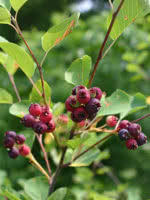Mon-Fri 9am - 5pm Mountain time
Western Snowberry vs Honeywood Saskatoon (Serviceberry)
Symphoricarpos occidentalis
Amelanchier alnifolia Honeywood
NOT AVAILABLE THIS SEASON - MIGHT RETURN
NOT AVAILABLE THIS SEASON - MIGHT RETURN
Like the Common Snowberry, the Western Snowberry is a small shrub with pink flowers useful for feeding livestock and preventing erosion. Unlike the common species, however, the Western Snowberry is much more suited to wet conditions, capable of persevering through poor soil drainage and occasional flooding.
After the Snowberry's flowers have bloomed, it produces berries which often last on the plant through winter. These berries are toxic to humans, but livestock and local wildlife love them! Those hoping to attract wildlife to their property can plant Snowberry and expect to see animals foraging on it much later in the year than other plants.
Honeywood Saskatoon, also known as Serviceberries, is excellent at producing an abundance of blue-coloured berries in mid-summer and has dark green foliage that turns yellow in the fall. It is quite large making it a perfect shrub in your backyard garden. Often grown for its edible qualities, the Honeywood Saskatoon is quite ornamental with stunning white blooms in the spring.
Western Snowberry Quick Facts
Honeywood Saskatoon (Serviceberry) Quick Facts
Toxicity: berries are toxic to humans

